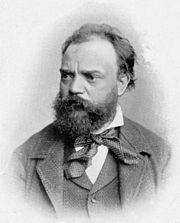The Ever-Evolving Composer
The first time that I had ever heard the 4th movement of Dvorak's 9th Symphony was in a video game called Asura's Wrath in 2013. In that game, the rebellious god Asura challenges his old teacher Augus to a battle to the death. As the two deities clash on the lunar surface, the finale to the New World Symphony begins to play as an accompaniment to the clash of fists. Watching this hot-blooded conflict as a high-schooler gave me stars in my eyes, and the song which played stuck around in my head for weeks, and I would find myself humming to it's tune as I walked to class. It was only later, of course, that I would even find out the symphony's name, and could listen to it on YouTube in it's entirety.
Antonin Dvorak (Ahn-toe-nin Di-vor-shack) was the typical musical prodigy common among famous composers having been proficient at the violin since the age of 6. He became famous after his death for mixing African spiritual melodies as well as Native American dances into his most famous work, the 9th or New World Symphony. Considered one of the greatest musical works of all time, a recording of it was brought by Neil Armstrong onto the Apollo 11 mission. Within 30 seconds of the 4th movement's beginning, we have the sort of leitmotif a nefarious warlord would have, as he crushes the world beneath his feet. It transitions into a lighter, but still gray repeating continuation, before descending into quiet, but hopeful stillness with the usage of the flute. Thus proceeds an optimistic march which is interspersed with several brief returns to that oppressing opening. Eventually, we reach the "Largo" of the piece which had been used by Dvorak's student William Fisher for the spiritual song "Goin' Home", which wears it's African influence on it's sleeve. We then transition to long stretches of tranquility before moving into the climax, a true return to the opening once more before the final minutes of victorious trumpets, marking the end of the piece.
Ultimately, the 4th movement tells a story, a story of darkness which conquers all and destroys peace before finally in the end being defeated by a simple good. It's a piece of music which I hold close to my heart.
Image Credit: "Antonin Dvorak" via Wikimedia Commons


This is one of my very favorite pieces. The contrasts are staggering and the melodies are all so strong, that each could stand alone. It is very developed and lovely.
ReplyDeleteI love that you say the beginning of the fourth movement could be the leitmotif of a nefarious warlord. It's so true! I love this piece, and Dvorak. I've spent many a night doing homework to his cello and piano suites!
ReplyDelete